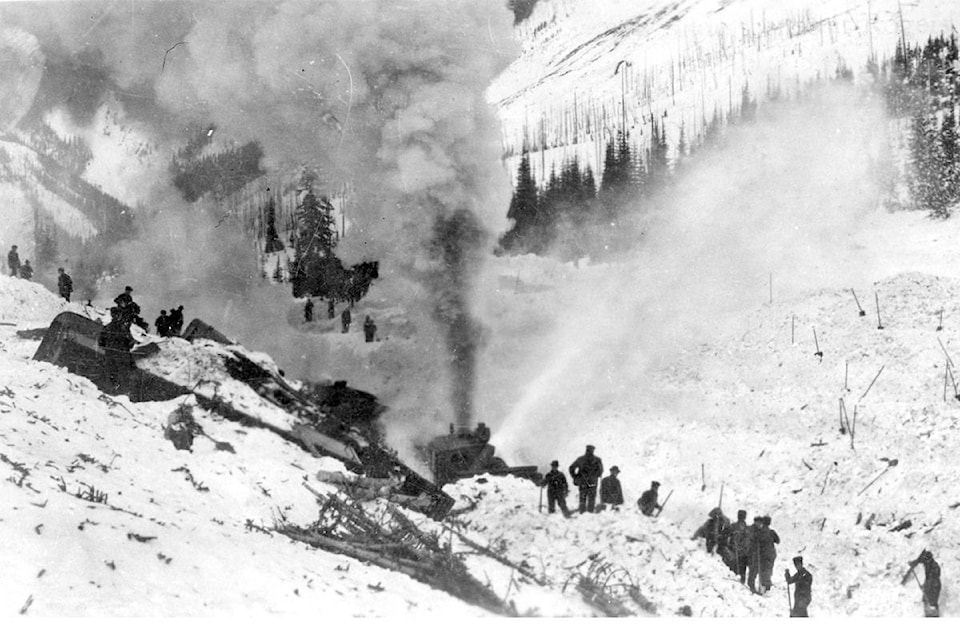The earliest recorded avalanche deaths in Canada are from 1782 when an avalanche struck an Indigenous community in Labrador.
Since then, hundreds of people have been killed by tidal waves of snow.
However, the avalanche of 1910 on Rogers Pass near Revelstoke stands out.
In the afternoon of March 4, an avalanche came down the slopes of Mount Cheops, burying the railway line and forcing a passenger train bound for Vancouver to wait for workers to clear it.
Soon, a work train arrived from Revelstoke. Scores of men toiled into the night digging a trench with shovels to clear debris and snow.
It was near midnight when the mountain fell down, a second time.
Reports from the Continental Daily News, a Japanese-Canadian newspaper, described the avalanche as sweeping down the mountain “with sound like thunder, breaking down many trees and flinging rocks along the path.
“Some of the people trying hard to escape from this white death were blown away like leaves.”
| The trench where the men had been digging became a tomb. When the mountain settled, there were few survivors. (Submitted by Revelstoke Museum and Archives P1250) |
The trench the men were clearing became a coffin. When the mountain settled, there were few survivors.
The final death toll was 58. Some of the bodies recovered beneath 10 metres of snow were found dead standing upright, frozen in place, reminiscent of Pompeii.
READ MORE: Online avalanche exhibit, Land of Thundering Snow, launches
The Revelstoke Museum and Archives said the victims from the disaster reflect Canada’s cultural mosaic, as they were English, Irish, Scottish, Danish and Polish.
However, the majority of those killed were Japanese, accounting for 32 of the dead.
Newspapers at the time said the incident threw Revelstoke into a town of mourning and chaos. It was the deadliest avalanche in Canada at the time and still is today.
| Funeral of Japanese railway workers. (Submitted by Tomoaki Fujimura) |
The accident not only caused large loss of life but was one of the reasons the Canadian Pacific Railway abandoned the railway line over Rogers Pass and built the eight kilometre Connaught Tunnel through Mt. Macdonald.
Although it has been 110 years, similar accidents still occur. Last month, at least 38 people were killed in Turkey trying to rescue others trapped by an avalanche. A second avalanche fell on the rescuers as they dug.
Tomoaki Fujimura, a ski guide and avalanche technician in Revelstoke, has been researching the 1910 avalanche for over a decade.
He’s even gone to Japan to knock on doors and track down relatives of people involved in the avalanche.
Eventually, Fujimura said he’d like to write a book on the disaster as told from the Japanese perspective.
Not only did the early trains that passed through Revelstoke bring tea and silk, but many of the railway workers were also Japanese.
Fujimura has found pay stubs from the Revelstoke Museum, showing there were 300 Japanese workers on the railway’s payroll at the time of the avalanche.
Of particular interest to Fujimura is how many Japanese railway workers or their family members were later sent to internment camps during the Second World War.
“I want to track down stories we don’t know.”
| Tomoaki Fujimura poses near the Japanese history display at the Revelstoke Museum and Archive. |
One story he has found is of Gennosuke Suzuki, who worked for the railway and was later sent to a camp near Kaslo.
Fujimura has been heavily involved with recent internment memorials, such as the one by Three Valley Gap that was unveiled in 2018.
“History is a tool to respect the people,” said Fujimura.
READ MORE: Roadcamp sign unveiled near Revelstoke by Japanese internment survivors
He said at many times, history is told through a Caucasian lens. The past is complex and perspectives interwoven.
“It’s time to talk beyond the deaths in the avalanche. We need to acknowledge our pasts.”
One example of acknowledgment said Fujimura would be for other flags to fly at Craigellachie, such as those of Japan, China and Italy.
“Fly the flags of the people that built the railway. That’s what a multicultural society is all about.”
The Last Spike at Craigellachie is where the ceremonial final spike was driven into the Canadian Pacific Railway in 1885, signaling the completion of the line across Canada.
Fujimura said he hopes to stimulate people to investigate the past. “I’ve done my homework. It’s time to get the stories out there.”
@pointypeak701
liam.harrap@revelstokereview.com
Like us on Facebook and follow us on Twitter.
